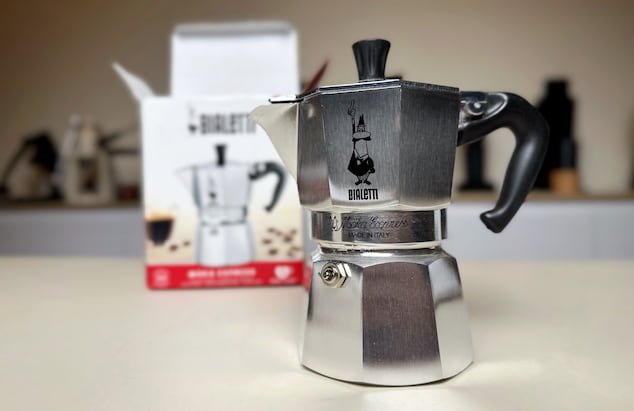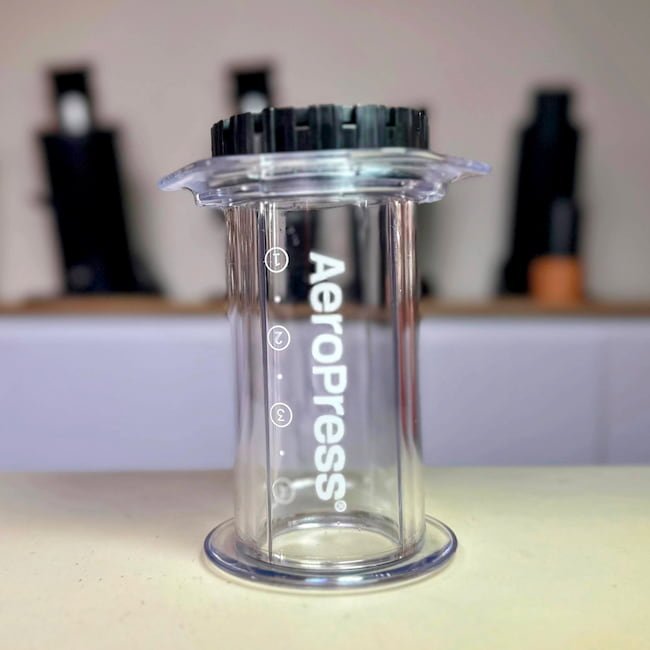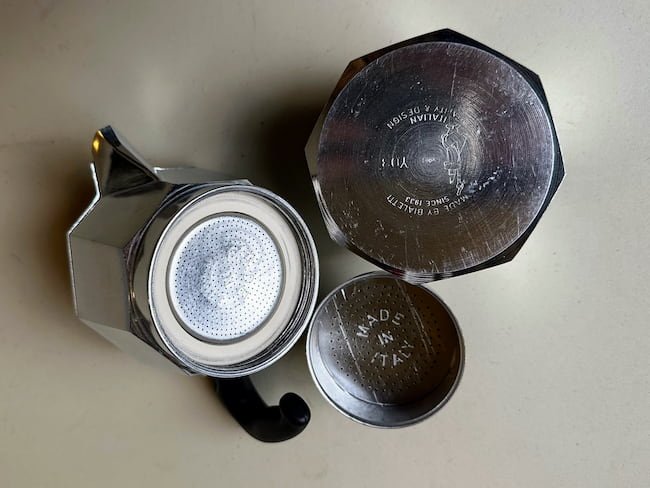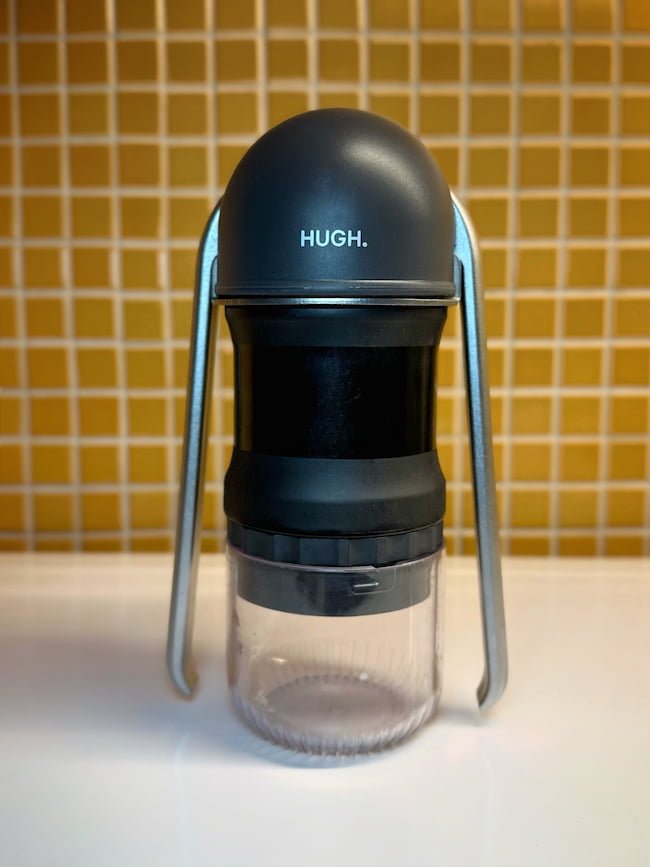The Bialetti Moka Express is one of the godfathers of coffee brewing.
It’s one of the most famous and widespread coffee makers ever created, perhaps only rivaled by the Bodum Chambord and the classic Melitta drip pot.
But the Moka Express was created all the way back in 1933. So that begs the question: Is the device still relevant today or is it somewhat dated, being almost 100 years old? 🤷♂️
So this isn’t really a “typical” review – no, this article is rather a devil’s advocate kind of take on the Bialetti.
What’s unique about it? Do we have better alternatives today? And do I still think it’s worth it in 2024? Let’s find out.
Perhaps the world’s most popular coffee maker

In many ways the Moka Pot Express is a relic from the past.
However, if you want “Americano” strength coffee on a budget, but don’t want to learn about extraction theory, grind size, etc, then it’s still relevant today.
History of Bialetti Moka Express
The stovetop espresso maker’s invention dates back to 1933, and was credited to Alfonso Bialetti.
Steam-powered percolation coffee makers existed before the Moka Express, but Bialetti’s innovation was in making this accessible for home users, and not just a coffee shop phenomenon. The Moka was also faster than traditional domestic coffee makers, and that’s the reason it was called “express”.
One of the most striking things about the device is the octagonal design. Researching for this article, I was bewildered to learn that the design was inspired by Miss Bialetti herself. This is what the company states:
“It was Alfonso’s wife who inspired the iconic 8-sided shape of the Moka with her silhouette: the head, the broad shoulders, the narrow waist, the arm on the hip and a pleated skirt …”
Quote from Bialetti’s official website
At first that made me very curious about the looks of Alfonso’s wife. But then I saw the original 1933 version of the Moka Express and it made sense. It does look more soft and feminine than the redesigned, angular version that became more prominent from 1950 onwards.
Bialetti’s son, Renato, took over the family business in 1945. He was a hugely successful businessman, and the Moka Express became deeply ingrained in Italian everyday life. According to The Local Italy, more than 90 percent of Italian households own a moka pot.
Worldwide, Bialetti estimates that some 200 million households own one of its products.
However, in spite of all this, Bialetti has struggled in recent years. The company has switched owners several times, until 2018, when the company declared bankruptcy and received a loan from an American hedge fund to survive.
Unboxing the Bialetti Moka Express
Over the years, I have of course, as many other coffee lovers been using the Moka Pot, on and off.
But recently I actually decided to buy the classic Bialetti Moka Express, the cute little 3-cup version that can brew around 130 ml’s.
I wanted to get it both to see how it felt to use a brand new one and what’s actually included. And also because I somehow lost my previous Moka pots when I moved from a shared flat years ago, and have never reinvested in a new one.

Out of the box, the Bialetti is a cute little device made of polished aluminum. It still retains that classic look that has become the archetype of the moka pot. However, the handle looks different from the one I remember from my childhood and youth. And yes, upon studying the official timeline from Bialetti, it appears that there was a redesign of the handle in 2004.
Along with the pot itself, you get a rubber gasket, filter basket, and instruction booklet. The box comes with the basics, but there are no fancy accessories:
The manual suggests brewing three rounds of coffee and discarding them in order to “season” the moka pot. I guess that’s a more rustic way of saying that there might still be some byproducts from the factory.
So overall, the Bialetti Moka Express looks like itself more or less. The handle is different, but the quality and charm is still there.
Is the Moka Pot express worth it today?
To answer that question, let’s take a look at how the Moka pot stacks up against some popular rivals. The most obvious one is the AeroPress. Another device that uses pressure to make coffee.
The AeroPress is a bit more “involved” than the Moka pot, but it offers a lot more versatility and control over the brewing process.
With the AeroPress, you can easily adjust the strength and flavor of your coffee by changing the amount of grounds and water you use, as well as the brewing time and technique.

With the Moka Express, it’s a lot harder to change the coffee to water ratio. First of all, you’re limited to the capacity of water in the base of the brewer. If you fill the chamber and the coffee basket, then you’ll get around a 1:10 ratio of coffee to water. Of course, you can take the Moka Express off the stove before and get a stronger ratio that is closer to espresso. However, it’s hard to get a properly extracted coffee if you do this.
The Moka pot doesn’t brew at the same pressure as an espresso machine, and as a result, you can’t use the same ultra-fine grind size. To reach the industry standard extraction of 18-22%, you need to push more water through the coffee.
Take the AeroPress on the other hand. You can brew very long ratios and very short ratios, because you can adjust both the coffee volume and the water volume. I’d say that everything from a 1:3 “espresso” style ratio to a 1:18 ratio is possible. It’s also very easy to weigh both input and output, so you have more control over the brewing process.
With a moka pot, you can weigh the input, but if you want to stop the brewing process before all water has been pushed through the coffee grounds, you’ll have a slightly awkward situation.
I have had very tasty results by trying to target a ratio of coffee to water around 1:6. So around 13 grams of coffee in the filter and around 80 ml out. But this requires me to “eyeball” the result, which is notoriously difficult.

So I’d say that the AeroPress is clearly a more flexible and consistent coffee maker.
Another advantage of the AeroPress is the sheer variety of recipes and techniques you can try. There are tons of different ways to brew with the AeroPress, from the classic inverted method to more experimental recipes that use different ratios of coffee to water or incorporate different brewing times and temperatures. With the Moka pot, you’re more limited in terms of what you can do.
The AeroPress is just a very smart design. But if you’re in a situation where you can’t access boiling water easily but you still have a heat source, then I could see a Moka pot being more handy. At a fireplace, for instance. In that scenario, it might be more convenient to have a Moka pot compared to an AeroPress.
Metal filtration vs paper filtration
You could say that’s all very well, and that the defining characteristic of the Moka pot is that the coffee is more dirty, a bit richer tasting due to the metal filter. But I’d also contest that. Actually, it’s possible to buy various mesh/metal filters for the AeroPress that allow for more coffee oils to end up in the cup.
Conversely, it’s also possible to add paper filters to the Moka Express. You can either use AeroPress paper filters or special “moka” paper filters that are available in various smaller sizes. If you just wet them a little bit they will stick to the metal filtration screen of the Bialetti Moka Express. The addition of the paper filter will clean up the cup dramatically, and make the nuances in flavor “pop” more. No matter which camp you’re in, paper vs metal filtration, you can get your caffeine fix with either device.
I’d argue that you can get the AeroPress to taste very close to a Moka Express if you want, while the reverse is a bit more challenging.
One of the things I love about the AeroPress is how quick and easy it is to use. You can have a fresh cup of coffee ready in just a couple of minutes, and cleanup is a breeze. Just eject the spent coffee puck into the compost bin and give the brewer a quick rinse. The Moka pot, on the other hand, takes a bit more time and effort to clean, especially if you let the coffee residue build up over time.
Does the Moka Pot express make real espresso?
Many people often confuse the two, but the Moka Express doesn’t produce true espresso.
It brews at lower pressures and with a coarser grind than espresso machines. It makes a strong, textured, and flavorful cup of coffee, but it’s not espresso. The moka pot brews at 1.5 bars and espresso is around 6-10 bars. One of the defining characteristics of espresso is crema. Although there are variations depending on coffee freshness and species (robusta makes a lot more crema), in my experience, it’s hard to get crema under 5 bars of pressure. So the moka pot is quite far from being an espresso device.
As mentioned above, the Moka pot also won’t be able to work with a super fine grind size. If the pressure gets too high inside the water compartment, a safety valve will let steam out. But now we’re getting a bit technical – many home coffee enjoyers don’t have the same kind of stringent and theoretical relationship with their brewing device. I’d also agree that the difference between a well-extracted moka pot and an Americano is more murky. Heck, I’d probably even prefer a good Moka brew over a poor Americano. So there’s that.

However, nowadays you have manual espresso makers that offer the same tiny footprint as the Moka pot but actually do offer real espresso. I have reviewed a bunch of them on this website and on my YouTube channel. Just to mention a few of them:
All these small, fun brewing gadgets can actually make real espresso. Some of them are a bit below 9 bars and some can even reach higher pressures (even though that’s not a good idea). If you want real espresso at home or while camping, then that’s totally possible today. There’s nothing holding you back. Granted, it’s a bit cumbersome to work with many of these devices and it does require a bit of a learning curve. You also need an espresso-capable grinder. But the point is that it’s doable.
There’s also the 9Barista device which I haven’t personally reviewed, but which looks very similar to a Moka pot, but can actually make real espresso.
So to conclude this section: The Moka Express doesn’t make espresso, but you do have many contraptions nowadays that do. Another nail in the coffin for the Moka Express.
What about cleaning and food safety?
For me, there’s no doubt that the AeroPress has the Moka pot beat when it comes to ease of use and ease of cleaning.
Contrary to popular belief, the Moka pot does need daily cleaning. Yes, you shouldn’t use soap, since it will damage the aluminum, but you do need to rinse off coffee residue with running hot water.
What about food safety and materials used? Well, both devices have been subject to some scrutiny.
Some time ago there was concern about aluminum coffee makers, like the Moka Express, and Alzheimer’s disease. However, this has been debunked, and many Alzheimer’s-related websites now clarify that there is no connection between the two.
On the other hand, many people are vehement opponents when it comes to plastics and hot water. To those people, there’s a new AeroPress Clear made of the supposedly very food-safe Tritan material, and in the future, we’ll also have an AeroPress Premium made of glass and steel.
But so far, I guess we have to say that it’s probably a draw here.
What about the Moka pot compared to the manual espresso makers? It’s hard to make a general rule here. Most of the more affordable espresso gadgets tend to rely on some plastic parts. With the more expensive versions, there will be more steel but likely there are some silicone gaskets.

The “Almost” Conclusion
The Moka Pot was a bastion of domestic coffee from its invention in 1933 and all the way to more recent times. But with the specialty coffee scene that began around twenty years ago, we have seen a dramatic increase in innovations – and now they are disrupting the Moka pot even further.
If you want to make true espresso at home or while camping, then there are much better options than a Moka pot.
If you want to have a flexible brewing device with easy cleaning that can make a very strong cup of coffee, well, then you can use an AeroPress. Just pop in a metal filter and use a 1:10 ratio, and then you’ll get something very similar to Moka pot coffee.
The “Twist”
But where I think the Moka pot still shines is in one arena that is shamefully neglected by the specialty coffee industry: The “medium strength coffee”.
Specialty coffee people are masters when it comes to creating tasty coffee that is either very strong or relatively weak. To give you some TDS percentages, that would be the typical filter coffee strength of 1.3% and the typical espresso of 10% strength. In terms of tools and knowledge around this, we have an abundance.
💡 Sidenote: TDS is a strength measurement that coffee people like to use. If there’s 1.3% strength, then that means that the remaining 98.7% is water.
The Moka pot, however, is great at making coffee in the 2-4% strength range. I would call that the “Americano range”.
Many traditional coffee drinkers absolutely love this type of strength. The moka pot is smart because it forces you to use a ratio that favors a medium strength drink. The metal filter also increases the mouthfeel and makes it more “Americano” like.
So on one hand, as a specialty coffee enthusiast, I think the Moka Express is antiquated. But on the other hand, I can’t think of any coffee brewing method that makes it easier for “normal” people to get that medium-strength Americano-like coffee with minimal effort.
So while the specialty coffee scene doesn’t need the Moka Express today, the average consumer still does.
➡️ Where to buy? Check price on Amazon
Our expertise & Credentials
- Asser Christensen earned his Q Grader license (certified coffee quality grader) in 2018, with recertification in 2021.
- The Q Grader exam requires passing rigorous blind tasting cupping protocols, as well as tests for identifying green bean and roasting defects.
- He has served as a sensory judge at roasting and coffee brewing competitions.
- Over the last 5 years, he has tested more than 50 different coffee grinders, as documented on this blog and his YouTube channel.
